Dunhuang Polychrome Sculptures Marvels
Text by Jeanne H. Tuan
Along the Silk Road, analogous to glistening pearls, numerous caves in the Gobi Desert showcase painted walls and grand statues, beautifully and expressively narrating the tale of Buddhism. Among them, the Dunhuang Mogao Caves, resembling top-quality radiant beads, vividly illuminate the diversity of various dynasties, ethnicities, and cultures. Despite their differences, they all express a common belief and pursuit. Skilled artisans and virtuous devotees from different social backgrounds come together to praise the divine. This cultural legacy, which blends the East and West, has stood firm for millennia and offers a precious gift to humanity. As the ‘Silk Road Splendid: Dunhuang Caves Art Exhibition’ is in full swing at the Fo Guang Shan Buddha Museum in Kaohsiung, Taiwan, attendees are presented with a unique opportunity to marvel at the intricately and impressive polychrome statues adorning the caves. These artistic wonders stand as significant landmarks, recounting the monumental journey of Buddhism.
The term ‘polychrome’ highlights the use of multiple colors in a single artwork, which creates a visually striking and dynamic effect. The Dunhuang Mogao Caves have splendid sculptures featuring Buddha and Bodhisattva figures. These sculptures are made of clay and have vibrant colors from natural minerals. The minerals used for these sculptures include cinnabar, malachite, azurite, ochre, calcite, and lapis lazuli. They bring life to the sculptures with vivid red, green, blue, yellow, brown, white, and bright blue. Also, the walls and ceilings of the caves have murals for decoration. The sculptures and murals in the Mogao Caves have colors that resist fading over time because of the natural minerals used to make them. The paintings and sculptures come together when the spectators kneel and look at the cave centers, forming a beautiful and harmonious tapestry.
Dunhuang cave art has featured polychrome sculptures for over 1000 years, dating back to the 4th century. These sculptures display a distinctive style that evolved in three stages. The first stage of Dunhuang cave art emerged during the 4th to 6th centuries when non-Han Chinese groups, i.e., Central Asians, established kingdoms in northern China, including the Dunhuang area. These kingdoms, known as the Sixteen Kingdoms and Northern Dynasties, introduced diverse artistic and cultural influences from Central Asia, India, and Western Asia to the Dunhuang region along the Silk Roads.
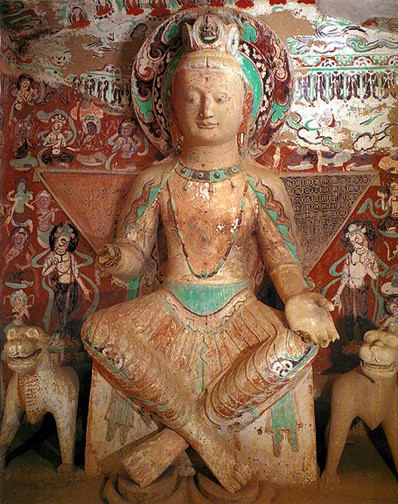
Figure 1: Maitreya Bodhisattva in Cross-Legged Position, Mogao Cave 275, Northern Liang Dynasty (420-29 CE.)
Figure 1 displays a statue that is 334 centimeters tall and located in Mogao Cave 275. It is thought to be the largest polychrome sculpture from early times. Sadly, the statue's right hand is missing, and the left hasn't been restored well. The statue depicts Maitreya Bodhisattva in Tushita Pureland, seated on a lion throne with a triangular backrest. Maitreya is wearing a slender, intricately detailed robe and has a Buddha-like headpiece on their head, along with necklaces. The facial features and garment style show influences from Western Asia, while the sculpting of the body reflects traditional Chinese techniques. The incised lines depicting the folds of the skirt are a unique characteristic of early Dunhuang sculptures.
Cave 259 is a beautiful cave temple that dates back to the Northern Wei period (386 to 534 CE). It is an excellent example of Western influence on sculptures and architectural designs. This cave has a remarkable polychrome sculpture, the Buddha in Meditation. A modern sculptor, Du Yongwei, has honored this statue by creating an equally exquisite replica (Figure 2), which is now on display at the Dunhuang Caves Art Exhibition at the Fo Guang Shan Buddha Museum.
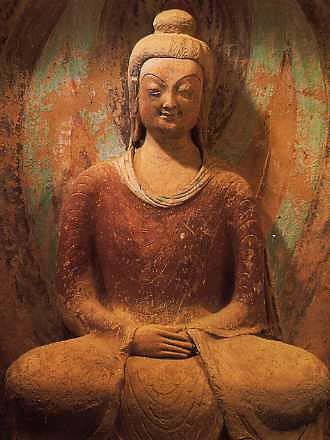
Figure 2. Buddha in Meditation, Mogao Cave 259, Northern Wei Dynasty (386 to 534 CE.), replicated by Du Yongwei (sculptor)
The statue of the Buddha is a sight to behold. It portrays the Buddha sitting in a relaxed position with legs crossed on a throne. The red garment draped over the Buddha is exquisitely incised to show the folds, making it look even more elegant. The statue has a substantial nimbus with a three-tiered flame motif that adds to its majestic presence. The Buddha's facial features, including the arched and elongated eyebrows, slanting eyes, flared nose wings, and upturned mouth corners forming two dimples, are intricately detailed, and revealing joy, peace, and enlightenment through meditation. This masterpiece emanates a tranquil and calming effect, making it stand out from other statues that portray solitude or ascetic suffering. The statue is a remarkable display of skilled craftsmanship and is worth a visit for those who appreciate art and culture.
The 'Silk Road Splendor: Dunhuang Caves Art Exhibition' at the Buddha Museum features a charisma ball from the Western Wei Dynasty (535-556 CE), with the centerpiece being the Central Pillar in Mogao Cave 432. This pillar reflects the fusion of Indian and Chinese influences and the religious practice of circumambulation. In this ritual, individuals walk around an altar featuring four Buddha statues. The architectural prototype of central pillar caves came from ancient Indian chaitya caves, where a carved Buddha stupa stands independently from the ceiling. The chaitya caves were designed to honor and remember the Buddha. The relics were placed at the center, and people walked around the stupa to show respect and reverence for the Buddha. As Buddhism spread to China, the stupa evolved into a square pavilion seamlessly connecting to the cave roof. In this new design, the square column not only upholds the cave's structure but also provides a platform for various Buddhist statues, establishing spaces for contemplation.
The central part of the pavilion pillar in Cave 432 remains the same as it did during the Western Wei Dynasty (535-556 CE), as Figure 3 displays. However, the rest of the cave, including the roof, walls, and base of the pavilion pillar, went through extensive repairs in the Western Xia period or the Tangut Empire (1038-1227 CE). These repairs involved restoring sculptures and motifs, depicting scenes with a thousand Buddha motifs, auspicious symbols, and Buddha’s dharma teachings. The gables also have adorned symbols of auspiciousness.
On the east facade of the pavilion pillar, a curved niche has decorative elements and holds a seated Buddha with Bodhisattvas on each side. The main Buddha is depicted to have a preaching posture, i.e., dharmachakra pravardana mudra, wearing Central Asian clothing, surrounded by a glowing nimbus with flame like patterns. Still, the strong body shows characteristics from Dunhuang art in the Northern Dynasties period.
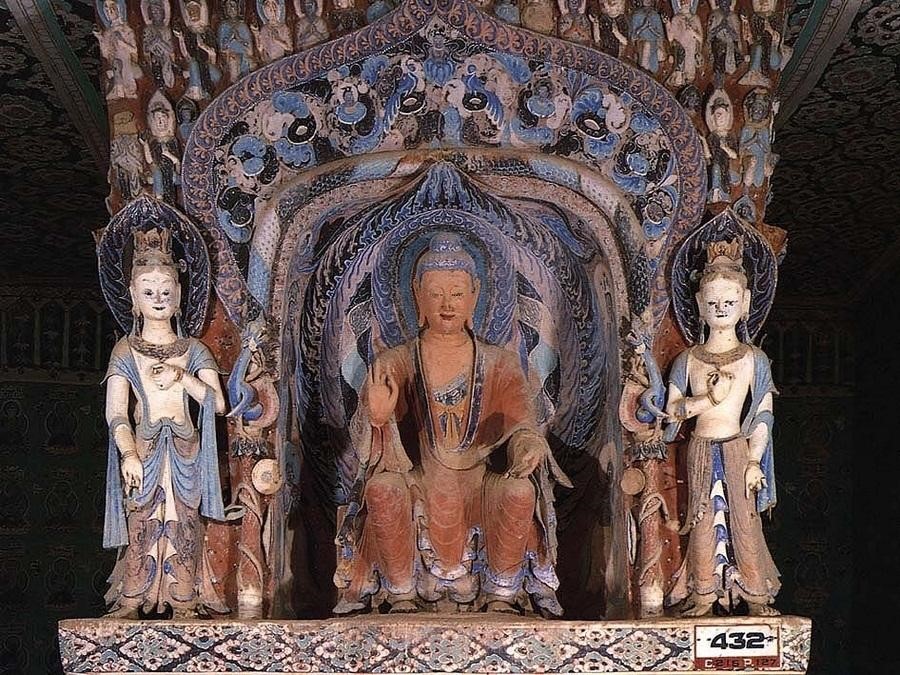
Figure 3. The East Facade of Central Pillar in Mogao Cave 432, Western Wei Dynasty (535-556 CE.)
On another side of the pillar, shown in Figure 4, a seated Buddha in a tree-like niche with recessed eyes and visible ribs represents Shakyamuni's rigid ascetic life. The statue emphasizes the importance of 'Chan meditation,' echoing a focus on practice seen in the 'Shurangama Samadhi Sutra' translated by Kumarajiva (344-413 CE.) and Buddha Bodhiruci's 'Dharmatrata Dharmadhatu Samadhi Sutra.'
Above the pavilion pillar are well-preserved shadow sculptures, paintings, and colored sculptures. The Buddha and Bodhisattva images show balanced shapes, reflecting the artistic style of that time. These images keep features from the end of the Western Wei Dynasty to the early Northern Zhou Dynasty, making them valuable.
The Bodhisattva images in the cave are in two types of attires (see Figure 5). The one on the south wears skirts and celestial garments tied in front, while the other in the center doesn’t have the knot. Besides, the figures on the north façade wear wide garments with celestial robes in front and Han-style clothing underneath. The figures are notably adorned with Han-style toe-up-warped shoes in pairs. The attires manifested on the images suggest a mix of clothing styles from that time. The Bodhisattva images have gentle smiles and compassion expressions, with exaggerated but balanced body shapes.
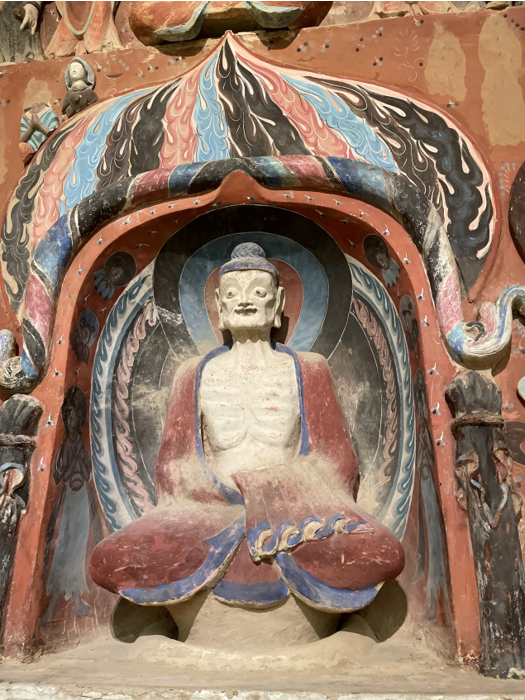
Figure 4. The West Facade of Central Pillar in Mogao Cave 432, Western Wei Dynasty (535-556 CE.)
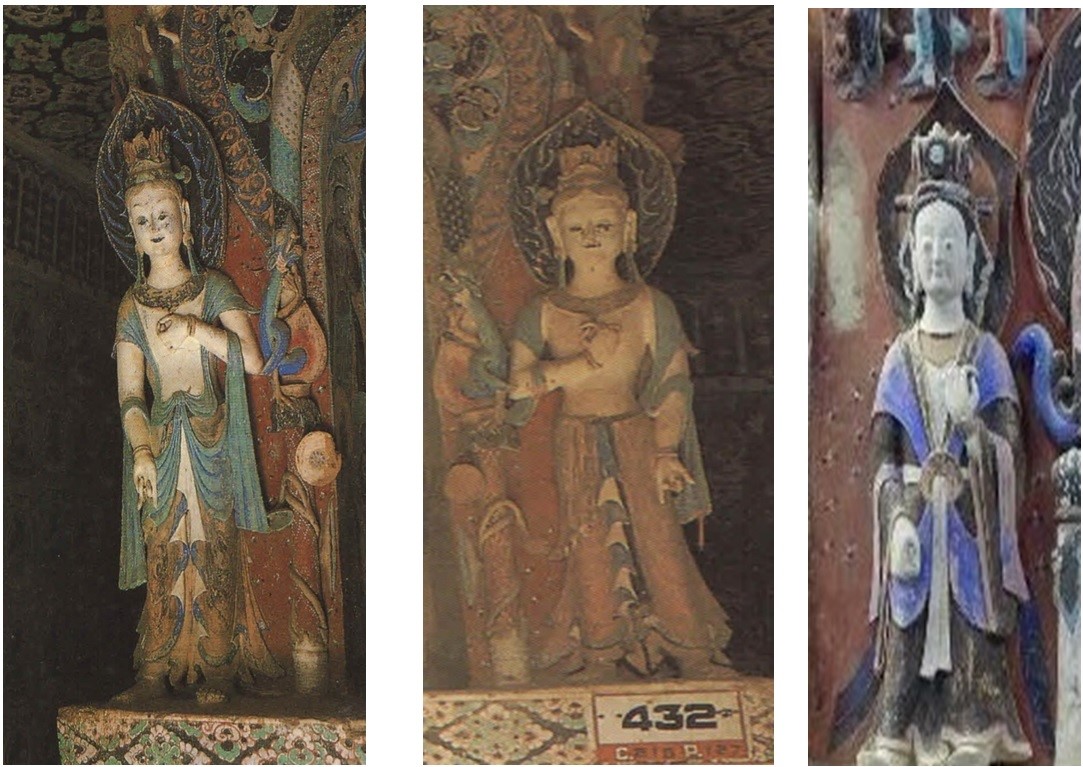
Figure 5: Attending Bodhisattvas of the East and North Facades of Central Pillar in Mogao Cave 432, Western Wei Dynasty (535-556 CE.)
Between the 6th and 10th centuries, during the Sui and Tang dynasties, China saw significant advancements in polychrome sculpture art. The polychrome sculptures of Dunhuang, in particular, reached their peak during this time and displayed exceptional artistic excellence. This era is widely regarded as the pinnacle of polychrome sculpture artistry in China. However, the quality of such sculptures declined over the next 460 years, coinciding with the reign of the Five Dynasties, Song, Western Xia, Khitan Liao, and Yuan, who successively governed Northern China.
The polychrome sculptures of the Buddhist Septad, located on the western wall of Cave 45 in the Mogao Grottoes, are considered a masterpiece from the High Tang Dynasty and hold significant artistic value. Therefore, it is crucial to appreciate the artistic representations of the Mogao Cave 45 replica, which is the central attraction of the ‘Silk Road Splendor: Dunhuang Caves Art Exhibition’ at the Buddha Museum.
Figure 6: The Buddha Preaching Dharma Sutra, Mogao Cave 45, Full View of the West Wall, High Tang Dynasty (705–781 CE.)
The central Buddha sits on an octagonal lotus pedestal, with a double nimbus adorned with flame patterns behind (see Figure 7). The left foot is placed on the right foot, known as the 'subduing Mara' posture, with the right hand in the gesture of preaching and the left hand resting on the left knee. The monk's robe is worn over the right shoulder, and there is an additional garment on the right shoulder. Although the facial features, neck, hands, and body color are not the same as originally, the meticulous solidity, balanced proportions, and the treatment of heavy clothing still reveal the beauty of the original creation. The outer edge of the double circular nimbus sculpted into a cord-like shape, adorned with golden color, and the outer layer is decorated with various auspicious floral patterns. It is further embellished with gradations of green, red, blue, and white colors, creating a dazzling and beautiful effect.
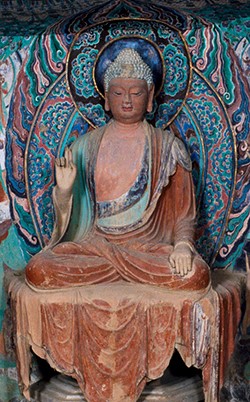
Figure 7: Sculpture of a Seated Buddha, Mogao Cave 45, Tang dynasty (618–907 CE.) Courtesy of the Dunhuang Academy. Photo: Wu Jian
On both sides, there are two monks, two bodhisattvas, and two heavenly kings (or Lokapala). Although their hands are later additions, the proportions and three-dimensional qualities still exhibit the distinct style of the High Tang period. The monk on the north side is Kashyapa, and on the south side is Ananda. Ananda's head is subtly tilted, presenting an aura of warmth, purity, and shyness. In sharp contrast, Kashyapa sports deeply furrowed brows, suggesting profound contemplation, and the overall portrayal is strikingly vivid and true to life. Kashyapa is depicted as an elderly monk, emphasizing his stern demeanor. He is regarded in Buddhism as an enlightened disciple, being foremost in ascetic practice. Opposite to Kashyapa, Ananda twists his body gracefully in a gesture of salutation, wearing a red robe over the inner garment. The natural and well-proportioned posture reflects the artisans' accurate understanding of the human body. Among the Buddha's many disciples, Ānanda stood out for having the best memory. Particularly noteworthy are the gentle and harmonious three-dimensional features of the facial expressions, as well as the subtle lines of the eyes, the restrained wisdom expressed in the nostrils and corners of the lips, making them outstanding examples among the Tang period colored sculptures.
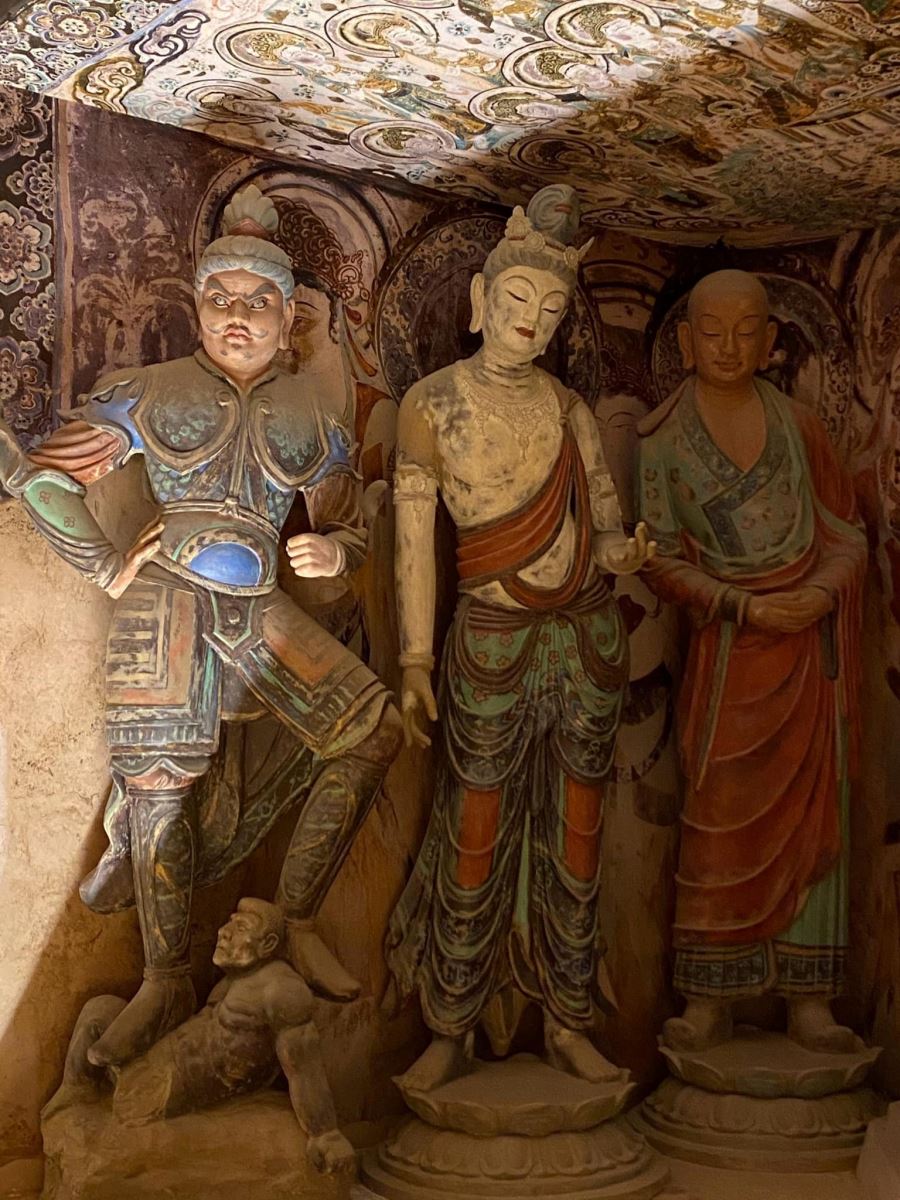
Figure 8: Standing Ananda (right), Bodhisattva, and Lokapala, part of The Buddha Preaching Dharma Sutra, Mogao Cave 45, High Tang Dynasty (705–781 CE.)
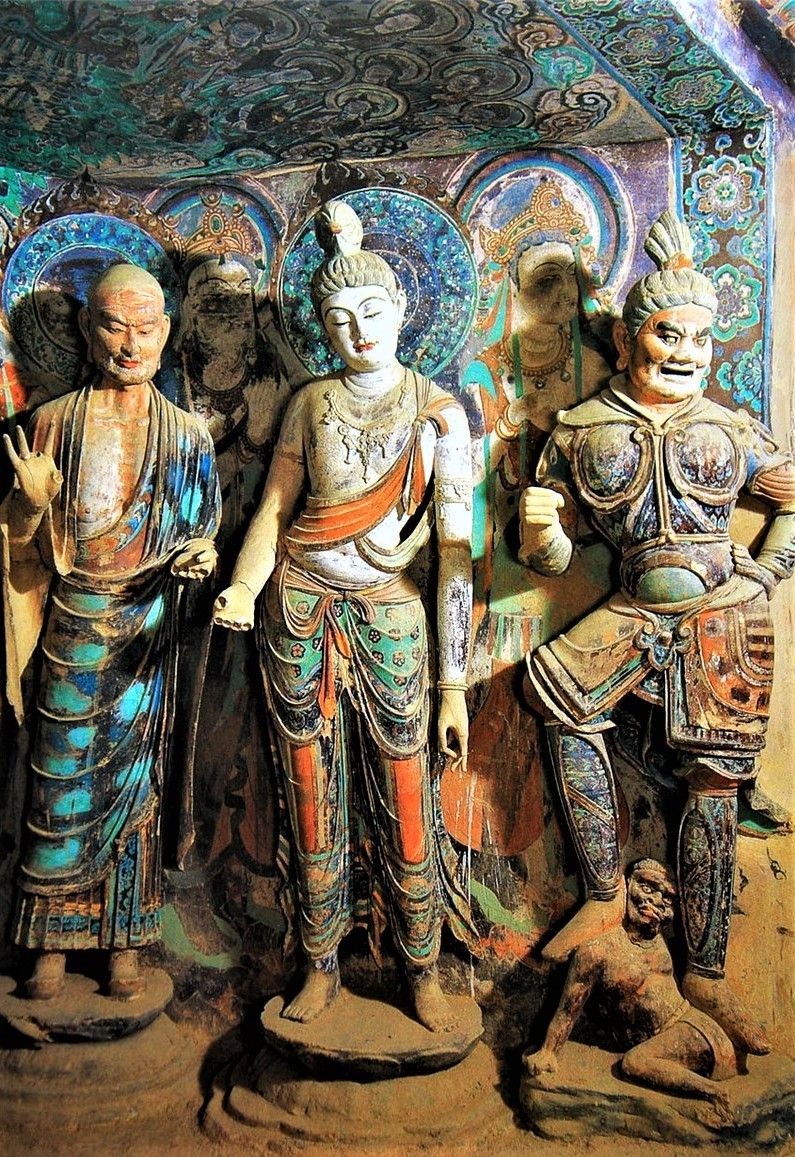
Figure 9: Standing Kashyapa (left), Bodhisattva, and Lokapala, part of The Buddha Preaching Dharma Sutra, Mogao Cave 45, High Tang Dynasty (705–781 CE.)
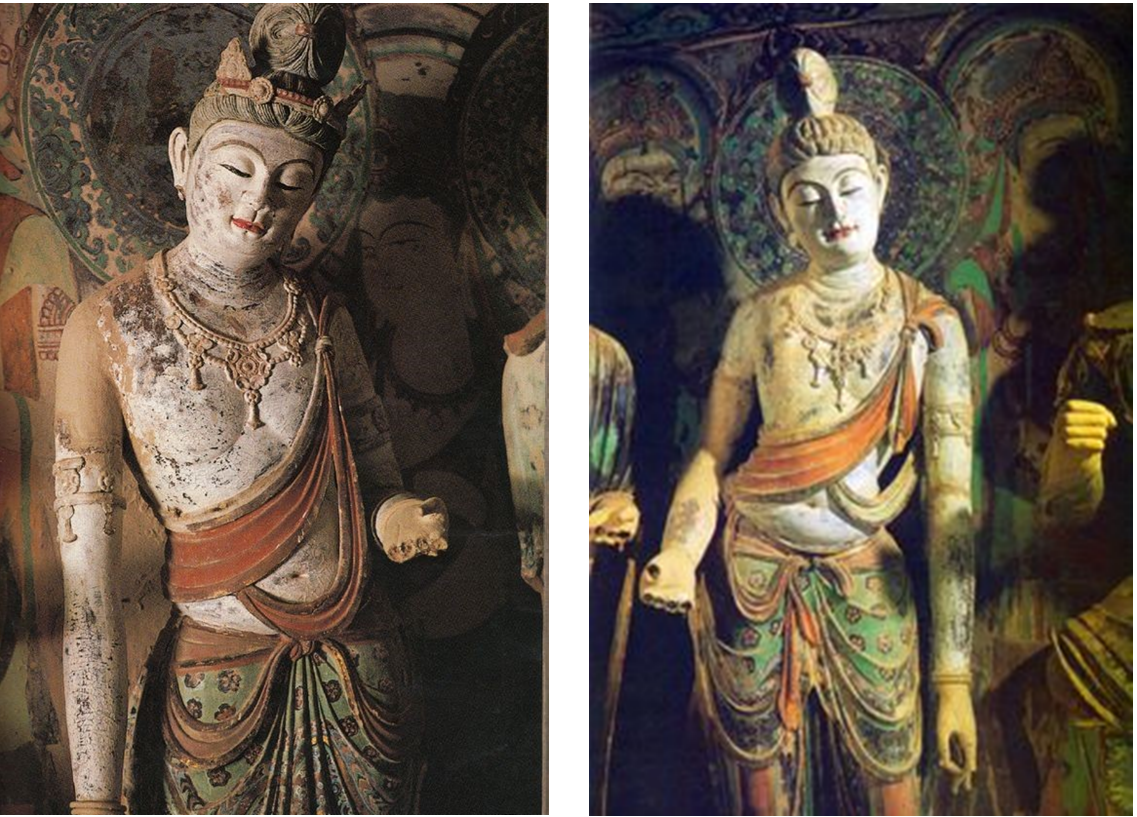
Figure 10: Close-ups of Attendant Bodhisattvas, part of The Buddha Preaching Dharma Sutra, Mogao Cave 45, High Tang Dynasty (705–781 CE.)
As Figure 10 demonstrates, the bodhisattva images show one hand bent and raised, while the other hangs naturally, in a tribhanga posture. However, the lower half of the body stands upright, creating a discordant pose with the three-fold style. The hair is tied in a high bun, adorned with a precious crown on three sides, and the upper body is exposed with chest ornaments and sashes. The proportions of the posture are exquisite, especially the elegant expression, giving a sense of feminine grace and beauty.
Within Mogao Cave 45, two representations of Lokapala, i.e., guardians of the sacred space, stand prominently to protect the Buddha. One holds a vajra in one hand, the other hand resting on the waist, both standing triumphantly atop evil spirits or demons. Clad in vibrant armor, they wear fierce expressions, with the northern deva in the A-form and the southern one in the M-form. Notably, their facial muscles slightly protrude, emphasizing the detailed and meticulous expressions that underscore their overall strength, realism, and vividness. The images also illustrate Chinese perspectives on self and others. Tang depictions of foreigners, identified as Huren (Central or Western Asians), often portray individuals with deep-set eyes and a high-bridged nose, commonly engaged in roles such as warriors, entertainers, and traders. The vision is exemplified most prominently in the two Lokapala images.
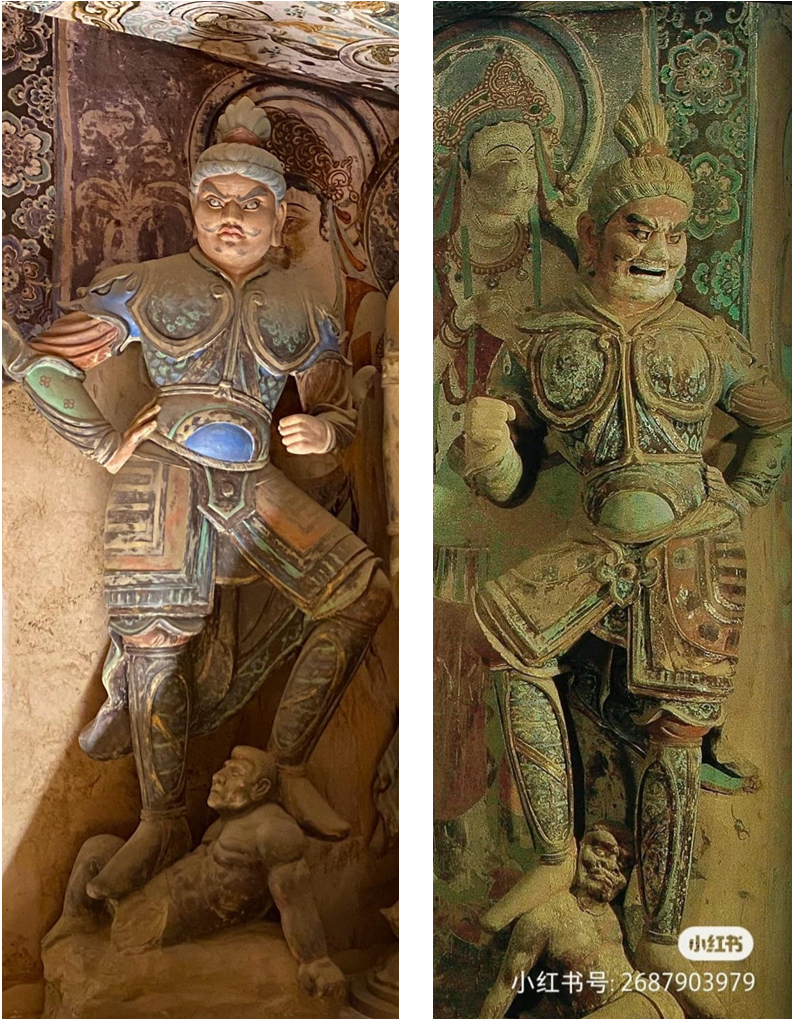
Figure 11: Close-ups of Lokapalas, part of The Buddha Preaching Dharma Sutra, Mogao Cave 45, High Tang Dynasty (705–781 CE.)
Another spectacle within the Dunhuang Caves Art Exhibition is the captivating display of deva statues featured in the window of Gallery 1. Originating from the High Tang Dynasty and residing in Mogao Cave 194, these statues represent Vaisramana and Vidradhaka, two Buddhist deities safeguarding the cardinal directions. The depiction of Vaisramana, the North Heavenly King, standing to the right, captures a commanding expression and a robust physique adorned with intricate armor details. The posture, reminiscent of a taut bow, suggests strength and agility, evoking a sense of tranquility and grandeur post-triumph. In a departure from earlier aggressive depictions, the artist opts for a static stance that radiates power and confidence.
On the left, Vidradhaka, the South Heavenly King, is portrayed realistically as a middle-aged military leader from ancient times. Featuring a high forehead, square face, sharp eyebrows, starry eyes, and a heroic demeanor, the character is complemented by a gracefully rendered flowing beard in reddish hues. The artist's adept fusion of meticulous line drawing with sculpture underscores remarkable skill and outstanding talent.
Remaining true to the typical artistic style of the Tang Dynasty, this artwork exhibits interplay of structural and painted lines in the polychrome sculpture. This harmonious combination effectively conveys strength, passion, and dynamic beauty throughout the piece.
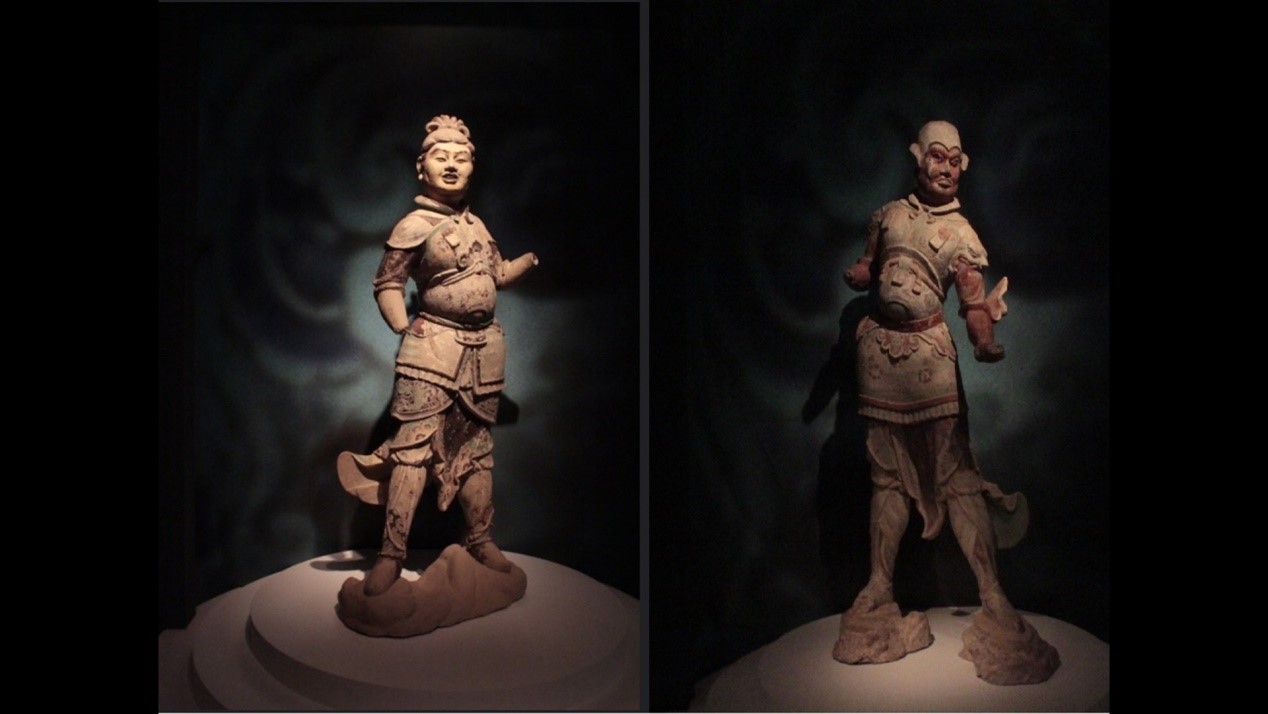
Figure 12: Vidradhaka (The South Heavenly King) and Vaisramana (The North Heavenly King), part of The Buddha Preaching Dharma Sutra, Mogao Cave 194, High Tang Dynasty (705–781 CE.)
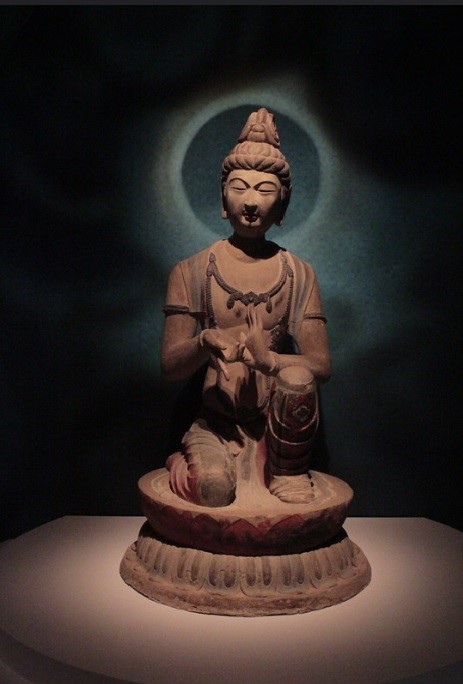
Figure 13: Kneeling Offering Bodhisattva, Mogao Cave 328, Dunhuang, High Tang Dynasty (705–781 CE.)
Financial contributions to craft images of Bodhisattvas or Buddha in caves were a popular way to earn religious merit in the past. This specific type of Bodhisattva images produced through sponsorship is known as "offering bodhisattvas." There is a marvelous masterpiece of an offering bodhisattva (Figure 13) from the High Tang Dynasty in Gallery 1 of the "Dunhuang Caves Art Exhibition." This representation of the offering bodhisattva, dating back to the late 7th Century, takes a kneeling posture in a gesture of serene reverence in Mogao Cave 32. The figure's devout expression subtly guides worshippers' attention towards the central Buddha. The intricately styled hair, formed into a high bun, mirrors lifelike depictions, while the finely crafted skirt and intricate upper body jewelry present remarkable skills in shaping figures during the Tang Dynasty. Unlike sculptures carved directly into cave walls, this portrayal emerged by applying a mix of clay, fibers, and straw onto a wooden framework, gradually solidifying. While a thin layer of white unifies the clay surface, color and gold embellishments have a final touch to specific areas.
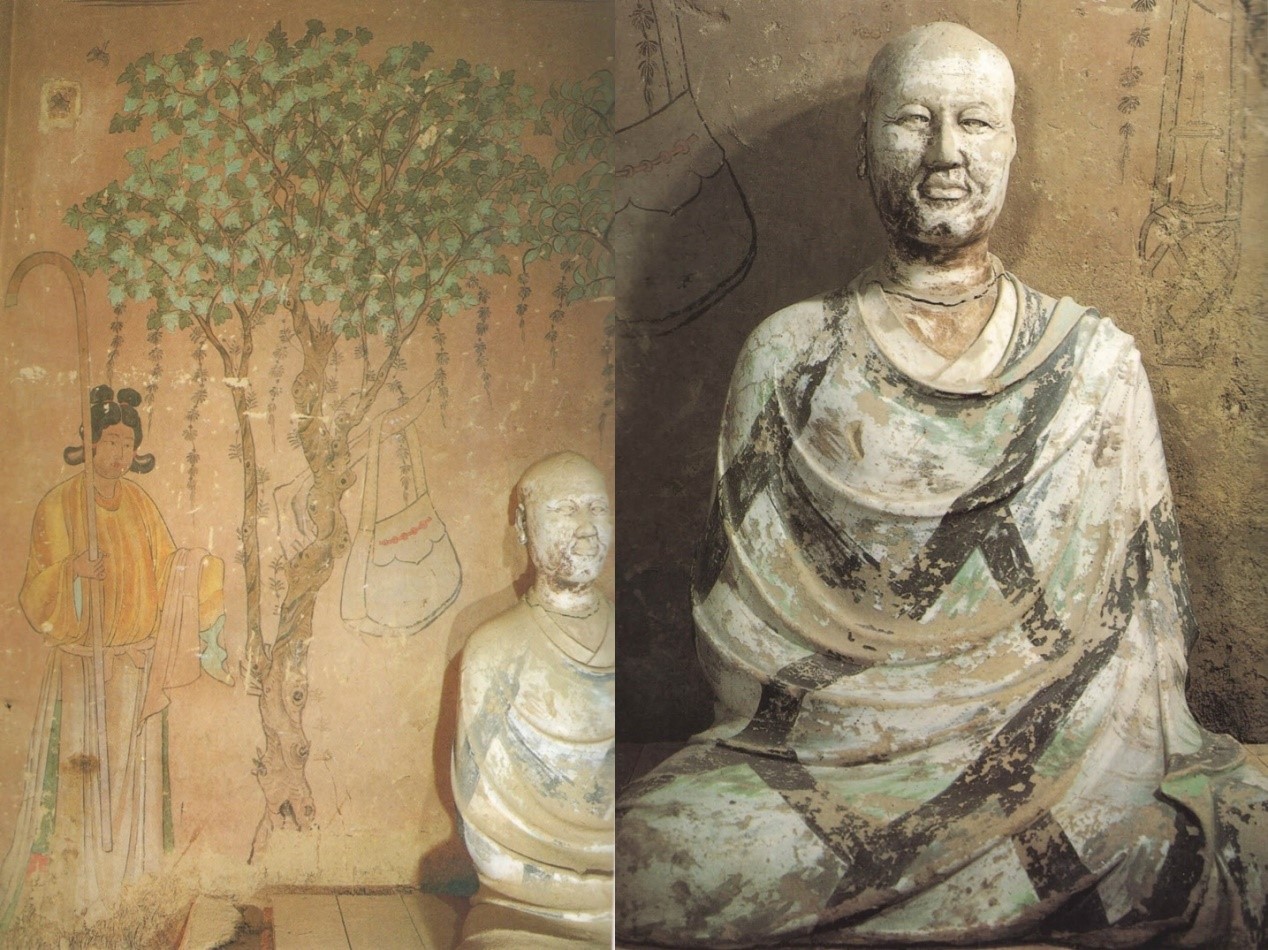
Figure 14: (Left) Portrait of a Standing Attendant under a Tree; (Right) Statue of Hong Bian in Meditation, Mogao Cave 17, Late Tang Dynasty (907-923 CE.)
In the Library Cave, the 94-centimeter-tall statue, as depicted in Figure 14, vividly captures the essence of the eminent monk Hong Bian. Draped in kāṣāya adorned with green-hued rice field patterns, the polychrome statue sincerely attempts to represent the venerable monk faithfully. The sculpture skillfully conveys a serious and aging facial expression, portraying deep wrinkles and folds that lend the figure an air of wisdom and experience. The characteristics reflect the unique East Asian trait of "distinctive flatness," presenting an aged Hanren monk with a notable bulbous nose and full lips.
Surrounded by a realistic mural, the statue is set against a narrative backdrop. The mural tells the story of an upasika, a child who receives the Five Precepts, positioned on the right side of Hong Bian beneath a tree. The upasika is depicted with a hairstyle featuring twin buns on top and wears a round-collar one-piece gown without a visible parting at the bottom. The figure's plump cheeks and robust physique reflect the prevalent artistic style of the Tang Dynasty.
Additionally, the mural incorporates a monastic bag hanging from the tree, characterized by coarse material adorned with knot decorative patterns. In Buddhism, the connected knots symbolize the continuity of the links of dependent origination. The artist's outstanding technique is apparent in capturing the blurs and shadows of the upasika's clothing folds and the vibrant greenery, establishing a sense of richness and vitality that breathes life into the composition.
During the High Tang period, the style of sculptures in Dunhuang changed from slender and graceful figures to more full-bodied and elegant representations, in line with evolving societal preferences. This preference for plumper and healthier forms continued throughout the Tang Dynasty, depicting robust health, delicate beauty, and vibrant aesthetics. In terms of color, sculptures from the Tang Dynasty featured a rich palette characterized by vivid and contrasting hues. The deliberate use of exaggerated colors enhanced the uniqueness of each character's personality, contributing to the visual appeal of art from that era.
During the late stages of polychrome sculpture in the Five Dynasties, Song, Western Xia, and Yuan periods, creating new caves became more difficult due to the required effort. Therefore, the most common practice was to modify, repair, and repaint existing Buddha images and figures within caves. Although the sculptures of the Five Dynasties followed the same structure as those of the Tang Dynasty, the overall artistic quality had noticeably declined. There were fewer polychrome sculptures in the Song Dynasty, and the Buddha and Bodhisattva images were less vibrant.
The Dunhuang Caves Art Exhibition at the Fo Guang Shan Buddha Museum is a testament to the enduring legacy of Dunhuang's polychrome sculptures. From the vibrant hues of the Buddhist Septad in Mogao Cave 45 to the awe-inspiring deva statues of Mogao Cave 194, the exhibition offers a panoramic view, immersing spectators in marveling experience.
Works Cited
Chang Zhenyang (張振陽) & Chen Qiuxiang (陳秋香), Desert Pearl Dunhuang 沙漠明珠敦煌. Taipei City: Geographical Publishing Co., Ltd. 台北市:大地地理出版事業有限公司, 1999.
Fan Jinshi (樊錦詩) & Zhao Shengliang (趙聲良). (Eds.) Duhuang Art Dictionary《敦敦煌藝術大辭典》,Shanghai Lexicographical Publishing House 上海辭書出版社, 2020.
Fan Jinshi (樊錦詩) & Zhao Shengliang (趙聲良). (Eds.) Experiencing Chinese Archaeology: Radiant Dunhuang 《親歷中國考古:燦爛敦煌》, Zhejiang Literature and Art Publishing House 浙江文藝出版社, 2023.
Lin Baoyao (林保堯) (Ed.) The Art Illustrative Records of Thungwang 《敦煌藝術圖典》, Taipei City: Artist臺北市:藝術家。1991.
Zhao Shengliang (趙聲良), The Artistic Treasury: Dunhuang Murals and Polychrome Sculptures《藝苑瑰寶——敦煌壁畫與彩塑》,Lanzhou: Gansu Education Press蘭州:甘肅教育出版社,2007.
Zhao Shengliang (趙聲良), "Dunhuang Cave Art: A Brief History,"《敦煌石窟藝術簡史》, Beijing: China Youth Publishing House北京:中國青年出版社,2015.